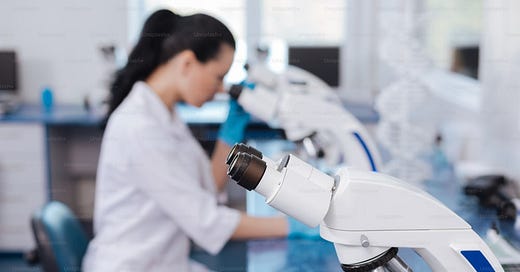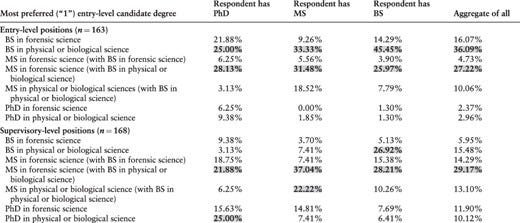Introduction
Survey after survey after survey after survey has reinforced the desire of forensic laboratory directors for science graduates over forensic science* graduates. Why is this? After an NIJ Working Group1 produced guidelines for forensic science* educational programs, in an attempt to align the academic system with the needs of the industry, they were adopted as accreditation standards2 by the American Academy of Forensic Sciences. The idea was to tease out the forensic-ness of a curriculum and how did it differ from a chemistry or biology curriculum; what was the same, what was different, in other words. Although the efforts strengthened forensic programs, the eventual results were less homogeneous than hoped for.
Some of Working Group’s efforts resulted in heated debate about if forensic science* was a separate discipline, as has been discussed here before. The real trick was convincing the lab directors that it was a worthwhile endeavor, given their historic and current preference for science graduates. It seemed as if they wanted a scientist, whom they would then tell what “forensic” meant, rather than a forensic scientist* who came in with their own views of “forensic.” More on that later but, first, a little history to show that none of these issues are new.
Ralph Turner
Ralph Turner was a pioneer in forensic science. A founding member of the American Academy of Forensic Sciences, his research developed standards for impaired driving was also the basis for drunk driving laws in the United States. Turner established the Crime Laboratory at the Kansas City Police Department in 1938. He then helped create the School of Criminal Justice at Michigan State University, one of the top criminal justice and forensic science programs in the United States3.
In 1975, Ralph Turner addressed an American Chemical Society Symposium on forensic science* education:
Undergraduate and graduate criminalistics programs have mushroomed from four in the 1940's to several dozen at the present time. As I understand the philosophy of these programs, they seem to be geared to producing technicians for a job market that is still very attractive. Some students appear to be fascinated by the potential glamour or mystery of the work, and some instructors detect a source of funds to enhance grantsmanship or irrelevant research. So far, I see little evidence of courses that introduce the student to the broad spectrum of forensic science…
That would, of course, change over time, with introductory classes in the forensic sciences* and some specialized courses, like fingerprints or forensic DNA. In his comments, we see the seeds of science as a persistent thread in the teaching of forensic students; he mentions two educational pioneers in forensic science*:
Returning to [Paul] Kirk and {R.H.] Mathews, it is interesting to note that both of these gentlemen were chemists who had distinguished themselves in their respective fields of biochemistry and physical chemistry. Considering the fact that proteges of these mentors have had considerable influence in shaping educational practices regarding forensic science training, it is no small wonder to me that we still see the basic curriculum for forensic scientists paralleling that of chemistry, physics or biology majors.
There has always been a concern with the proliferation of forensic programs, of quantity over quality; this was only exacerbated by the “CSI Effect,” whatever that really was.
Part of this is, to me, that faculty in established departments look down on forensic science* as being merely applied science, methods and tools that any competent (read: Real) scientist can easily do. You never see a bunch of biology faculty say, “Let’s start a Physics program!” If you don’t have a knowledge domain, an “academic space,” very little can happen inside a university; you’ll always be a lesser thing. Turner was also worried about this more than 50 years ago:
…a potentially serious problem which I see also emerging in America; namely the sacrifice of quality for quantity. I need only to refer to the rapid proliferation of forensic science programs in this country and suggest that we carefully review the quality of these programs. Specifically, quality has been sacrificed when we consider how quickly some of these programs have been organized, how minimal the qualifications of instructors are in some instances, and how seemingly obsessed some programs are with the acquisition of costly and elaborate instrumentation with very little forensic science expertise to build upon.
Of course, getting experienced forensic practitioners to teach in universities can be a trick: Most don’t have graduate degrees and very few have doctorates, so the universities don’t recognize them as being qualified for teaching at that level.
Ironically, this is exactly what the curriculum needs and the students want.
But it’s not what lab directors want
In a recent survey, lab directors said they want novice hires to have a bachelors in biology or chemistry; if they’re hiring a supervisor, they’d like a masters in forensic science:
Results indicated a continued preference for a degree combination of master’s in forensic science and a bachelor’s degree in physical or biological sciences for both entry- and supervisory-level candidates. Holding only a bachelor’s in the physical or biological sciences was also preferred for entry-level candidates whereas the preference for supervisory-level candidates was strongly influenced by the respondents’ terminal degree.
Thus, was ever the same, despite the creation and expansion of FEPAC-accredited programs. In fact, after all the efforts of the Working Group and FEPAC, no one cares:
We found that the majority (95%) of respondents did not require candidates graduate from FEPAC-accredited programs. Most (66%) did not pay attention to whether or not candidate degrees were conferred from FEPAC-accredited programs.
Truly, those who should be the main beneficiaries of industry-focused and accredited educational bachelor programs couldn’t care less (95%!). Yet, they embrace (if weakly) a masters degree in the same field. Is it that “masters = more science”? If so, why not a masters in chemistry or biology (a 15-point difference)?
Let’s hope researchers continue these lines of inquiry to find out what lab directors are thinking and why they’re avoiding forensic programs.
Mind the Gap
Training is expensive. Other than hiring a new employee, training is the next biggest personnel expense an organization has. Companies spend 2% of the employee's total cost-to-company on training but science is more expensive than that, about double the scientist’s annual salary. What lab directors would love is for a new hire to step in and start casework the next day, but that can’t happen. Even with the promulgation of standards, each forensic laboratory does things a bit differently, due to instrumentation, methods, history, and jurisdictional requirements. I call this the “jurisdictional problem.” With 400+ forensic labs, who-knows-how-many forensic service providers, and almost 18,000 law enforcement agencies in the U.S., educational programs can only go for the core competencies: They literally cannot make case-ready graduates. And post-graduate trainers are in a similar boat; you can only train so far to an agency’s protocols without training those exact protocols. All they can do is close the gap between graduation and the bench. Eventually, the lab needs to step in and finish the training to their processes.
Training constitutes intermediate and self-learning, a combination of guided and self-led accumulation of knowledge and mastery over topics and activities:
The second stage, training, represents an intermediate learning stage. The learner understands the fundamentals of a topic and only needs a brief overview of the procedure by the teacher. Certifications, in-house training, corporate universities, seminars, and short courses could be classified as stage two methods.
In the third stage, self-training, the self-learner is able to learn in isolation, perhaps from books, monographs, webinars, professional magazine articles, white papers, or product bulletins. The learner then self-tests for competence and applies the methodology to offer a solution. In independent learning, the topics are chosen by the student, and they evaluate their own proficiency.
How to close that gap, however? Approaches differ. Putting more industry-specific information into the curriculum helps, but that is dependent on the faculty knowing the industry (many “forensic” faculty have never done casework or worked in a forensic organization), the program having the right instrumentation and consumables, and the effort needed to integrate this into the curriculum. Microcredentialling is another approach, using bite-sized and stacked content to fill-in between academic learning and industry practice.4 Other methods, like internships, are waning, in part due to lingering cultural changes from the pandemic, liabilities, and lack of resources to manage interns, but also because unpaid internships are considered by many to be unethical.
(For resources, see5)
What is Next?
A few thoughts, purely from my experience, that are my opinions alone:
Academic forensic offerings need to have an administrative home. “Sharing” forensic resources with biology or chemistry departments only bleeds away the forensic-ness of any content: The home department always wins because it has a home. To have a say in what happens to you and what resources you get, you have to sit at the adults’ table.
Universities need to accept “Professors of Practice.” Business schools know that if you’ve run a successful company for 20 years but you only have a bachelors degree, you still have a lot to teach students about business. Medical schools realize this as well, calling them Clinical Professors. They are “usually non-tenure-track positions which can be full-time and permanent, but whose teaching tends to focus on practical rather than scholarly expertise.” Universities need to get over themselves and expand this idea to other disciplines, including forensic science.
Embrace online learning. Yes, some things can only be taught in person (you can’t mouse a pipette) but so much material can be leveraged in online training that, when you do get into the lab, the practical learning goes much faster. That’s one of the benefits of digital badges (resulting from microcredentials): You can see exactly what the learner gained from the experience.
Improve online learning. Most of it sucks, to be honest. Watching a voice-over slide deck is like watching paint dry, and that’s being unfair to wet paint. Use exercises, videos, animation, and other interactive content to make learning interesting and engaging.
Labs need to also get over themselves and understand they have a responsibility to train new employees. What the labs do, their protocols, may be specific to them but they’re not “special.” Don’t put experienced hires on the same track as novice hires; test them out to their level, then start the training from there. Yes, that takes time and thought but see the previous two points.
The American Society of Crime Laboratory Directors is having a meeting soon with forensic educators to discuss “the future.” Let’s see what the future might look like.
Disclosure: In my role as Director of the Forensic Science Initiative at West Virginia University, that office funded the Working Group and I oversaw its work product and meetings.
Another disclosure: I Chaired FEPAC for two terms (6 years).
Third disclosure: I graduated with a B.S. in Anthropology in 1984 and an M.A. in Anthropology in 1988 from MSU; I took undergraduate and graduate courses in forensic science* from that program.
Final disclosure: My main employer, FIU, offers online content and microcredentials/digital badges in forensic topics.
https://www.opm.gov/policy-data-oversight/assessment-and-selection/job-analysis/job_analysis_handout.pdf; https://www.shrm.org/topics-tools/news/hr-magazine/how-to-conduct-skills-gap-analysis; https://www.wikihow.com/Develop-Training-Materials.








